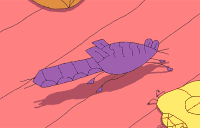
READING TO LEARN
CREEPING & CRAWLING INTO SUMMARIZATION
By: Sydney Beatty
Rationale:
Reading helps students to learn new information. While reading, it is crucial for them to differentiate between important and insignificant information. In this lesson, I will help students pick out the important information they need to remember. Summarizing is a skill that all beginning readers need to practice in order to be successful in reading comprehension. This lesson is going to teach students I will then model how to summarize an article read aloud to the class. To conclude, the students will practice summarizing the new article independently and be evaluated.
Materials:
-
Pencils and Paper for the students
-
“Meet the Hickory Horned Devil, a Fierce but Harmless Caterpillar” article for each student
-
“Fun Facts About the World’s Biggest Beetle” article for each student
-
Main Idea and Details image
-
White board to write the rules for summarizing
-
Summary checklist
-
Summary assessment rubric for evaluation
Procedures:
-
Say: “Today we are going to learn a new reading strategy called summarization. This is very important to learn because it helps us comprehend when we read stories. Can anyone tell me what summarizing means? (Wait for the correct response). That’s right! Summarizing is picking out the important parts of the story and getting rid of the parts that are not important.” The teacher will give the students an example of a flower with “details” written at the bloom/petals and the stem labeled “main idea.” This will be a great example for the students to visually get the idea of getting the details narrowed down to the most important parts which will make up the main idea in the story. This also shows the students how all the details and the main idea are connected. Teacher will say, “In order to summarize, we first need to understand the many rules that go into making summarization important. The rules are: cross out the unimportant details, reduce parts of the text into fewer words, and choose a topic sentence.”
-
Say: “Now we are going to read an article and try to pick out the main ideas since we know the different rules that go into summarization. If you forget the rules, look to the board. Remember, we need to summarize in our own words.”
-
Pass out a copy of the article, “Meet the Hickory Horned Devil, a Fierce but Harmless Caterpillar” to each student.
-
Say: "We are going to read this article together as a class and practice the skills we have discussed to come up with a summary together.”
-
Teacher will read the article aloud to the class as they follow along with their own copy.
-
Teacher will model how to summarize the article to the students to begin with and remind them of the rules.
-
Say: "Now we need to summarize the article. How do we begin? (Allow wait time for students to suggest how to begin summarization) Right, let's pick out important details and mark out unimportant details as we read the article again. To do this, we need to think about the things that are mentioned more than one time. As I read the first few sentences, I see that a Hickory Horned Devil caterpillar is very important to this article. This article talks a lot about the HHD getting ready to become a moth. My first sentence in my summary will be, “The Hickory Horned Devil has to eat a lot before it can begin to change.”
-
Say: "Picking out these main ideas is very important. After we do this, we have to decide what the author is trying to say about the topic. Let's look again at the article. Now I am going to write "Before the Hickory Horned Devil Caterpillar turns into a moth, it uses special tools, like its looks, to scare away from predators.
-
Continue to go through the steps of summarizing this article about HHD. Continue thinking aloud so that students can hear how to decide what information about the article is important and what is unnecessary information that can be marked out. Underline important information, mark out unnecessary information
-
Pass out “Fun Facts About the World’s Biggest Beetle” article. Students will read the article and practice the steps of summarizing. They will be given a substantial amount of time to read the article. Once they have read the article they will be instructed to write a summary based on their reading just like the one previously modeled. Each student will receive a checklist to remind them what to look for when summarizing
Summary Checklist:
Did I…
_____ write my topic sentence?
_____ find supporting details to help answer the question?
_____ remove unimportant information by crossing it out?
_____ remove repeated ideas?
_____ create a 3-5 sentence summary?
Assessment:
The teacher will collect the student’s summarizations from the second article and evaluate based on the table below.
In his/her summary, did the student….
Did the student pick out the most important information?
Did the student delete unnecessary information?
Did the student fully understand the information from the article?
Did the student write a strong topic sentence?
Did the student write strong sentences summarizing
the important part of the text?
References:
“Meet the Hickory Horned Devil, a Fierce but Harmless Caterpillar” article
“Fun Facts About the World’s Biggest Beetle”article
https://www.kidsdiscover.com/quick-reads/34551/
Laney Walding, Super Sweet Summarizers
https://sites.google.com/site/waldingseducationwebpage/super-sweet-summarizers
Click here to return to Applications:
http://wp.auburn.edu/rdggenie/home/classroom/applications/
Contact: slb0061@auburn.edu
NO
YES